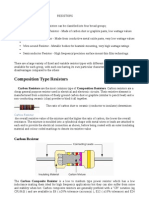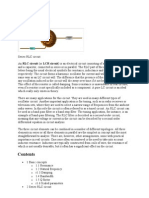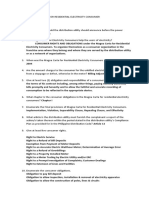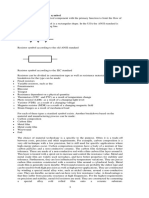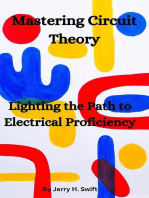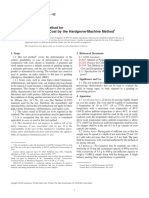What Is A Resistor
What Is A Resistor
Uploaded by
emilcioraCopyright:
Available Formats
What Is A Resistor
What Is A Resistor
Uploaded by
emilcioraOriginal Description:
Original Title
Copyright
Available Formats
Share this document
Did you find this document useful?
Is this content inappropriate?
Copyright:
Available Formats
What Is A Resistor
What Is A Resistor
Uploaded by
emilcioraCopyright:
Available Formats
TOKEN
What is a Resistor
What is a Resistor
Preview
Resistor is electrical or electronic components
which resist the flow of current across the resistor device.
The resistance to current flow results in a voltage
drop across the resistor device. Resistors are used
extensively throughout electrical and electronic ircuits.
Resistor devices may provide a fixed, variable, or adjustable
value of resistance. Adjustable resistors are refers to as ostats,
or iometers. Resistor values are expressed in Ohms,
the lectric resistance unit.
Resistors are incorporated within a electrical or electronic circuit
create a known voltage drop or current to voltage relationship.
If the electrical current in a circuit is known (current is measured in amperes), then a resistor can be
used to create a known potential difference (voltage difference) proportional to that current. Conversely,
if the voltage drop (potential difference) across two
points in a circuit is known, a resistor can be
used to create a known current proportional
to that difference.
An attenuator is a network of two or more
resistors (a voltage divider).A line
terminator is a resistor at the end
of a transmission line or daisy
chain bus, designed to match
impedance and minimize reflections
of the electronic signal.
Version 2010
http://www.token.com.tw/
rfq token.com.tw
01 of 07
TOKEN
What is a Resistor
What is Ohms Law?
I = Amperes
P = Watts
Volts
Amperes = Ohms
Watts
Amperes = Volts
Watts Volts X Amperes
Watts = Amperes2 X Ohms
Watts =
Volts2
Ohms
V = Volts
I *R
V2/R
V/R
P/V
Watts
Amps
Volts
Ohms
P*R
Volts = Watts X Ohms
V*I
P/I
Watts
Volts =
Amperes
P/R
Amperes =
P/I2
V /P
2
I*R
V*I
R = Ohms
Watts
Ohms = Amperes2
Volts2
Ohms = Watts
Volts
Ohms = Amperes
Volts = Ohms X Amperes
Ohms law is a simple equation that shows the
relationship between resistance, voltage and
current through a metal wire, or some other type
of resistive material. In mathematical terms,
Ohms law is written as:
I = V/R ,
where I is the current (Amps), V is the voltage
(Volts), and R is the resistance (Ohms).
02 of 07
Watts
Ohms
http://www.token.com.tw/
Ohms law can also show the relationship between
resistance, voltage and power using the following
equation:
P = V2 /R ,
where P is the power (Watts), V is the voltage
(Volts), and R is the resistance (Ohms).
rfq token.com.tw
Version 2010
TOKEN
What is a Resistor
Types of Resistors
Fixed Resistors
A fixed resistor is one in which the value of its resistance cannot change.
Non-Linear Resistors
A non-linear resistor is a resistor that has resistances that vary significantly with applied voltage,
temperature or light.
Types of non-linear resistors are varistors, thermistors and photoresistors.
Metal-Film Resistors
A type of cylindrical resistors made by depositing a resistive
element made of a thin conducting film of a metal or metal alloy,
such as nichrome,
onto a cylindrical ceramic or glass core.
The resistance is controlled by cutting a helical groove through
the conducting film.
Metal Oxide Resistors
A type of cylindrical resistor that uses materials such as ruthenium oxide or tin oxide as the resistive element.
These resistors can be excellent high-voltage or high-power devices.
Thick Film Resistors
Specially built surface-mount film resistor that carries high power
for the part size.
For thick film resistors, a ruthenium oxide film or metal glaze film
is applied using traditional screen-printing technology.
These resistor film can be excellent high-voltage or high-power devices.
Thin Film Resistors
A type of surface-mount film resistor with a relatively thin resistive element, measured in angstroms
(millionths of an inch).
Thin film resistors are made by sputtering (also known as vacuum deposition) a resistive material, such
as nichrome or tantalum nitride, onto the surface of a substrate.
Version 2010
http://www.token.com.tw/
rfq token.com.tw
03 of 07
TOKEN
What is a Resistor
Carbon Composition Resistors
A general class description for resistors consisting of a carbon mixture resistive core and a molded outer insulating
core.
Ceramic Composition Resistors
A type of resistor that consists of a clay, alumina, and carbon mixture that has been blended and pressurized into a
resistive core and then covered with a molded outer insulating core.
Carbon Film Resistors
A general class description
for cylindrical resistors made
by depositing a carbon film
on the surface of a center core insulator.
Wirewound Resistors
Consist of a cylindrical core which is wrapped or wound
with wire.The cylindrical core is typically made from
a ceramic, plastic, or fiberglass core material.
The wire is a type of resistance wire, such as nichrome. Wire
wound resistors are a type of power resistor and are accurate.
Wirewound resistors are available as fixed, or adjustable to
be used as a rheostat or potentiometer.
Typical application for wirewound resistors include device
requiring high current handling capability, heat dissipation
and resistance stability and accuracy.
High Precision Resistors
A variety of test instruments rely on stable, low TCR, High accuracy Resistive
devices for use as reference devices in their circuits.
While there are low cost metal film, chip devices, and wirewound resistors
which offer the desired characteristics, Tokens Thin-Film technology
is unique in their performance as they could offer very high stability
with very low TCRs and the ability to give a long drift free service.
Neutral Grounding Resistors
Neutral grounding resistors are incorporated into electrical circuits to protect the system and devices.
Neutral grounding resistors protect electrical circuit components by limiting the ground fault current to an
acceptable level.
Within three phase electric voltage system, the neutral branch is referenced to ground (earth).
In the event that a current fault occurs (short to ground), extreme current causes by the fault will damage electrical
circuit system and components.
By installing a neutral grounding resistor, the faulty current will be limited to a predetermined level.
04 of 07
http://www.token.com.tw/
rfq token.com.tw
Version 2010
TOKEN
What is a Resistor
Dynamic Braking Resistor
Dynamic Braking Resistor is a high power / wattage resistor
used by a electric motor to assist in the process known as
dynamic braking.
DC motors, unlike AC motors, act like a electrical
generator when the motor has been disconnected from
the power source.
The motor functions like a generator due to the DC motors
permanent magnet. The resistance to rotation causes the
dynamic braking.
The voltage and current produced by the DC motor
generator) is directed into the dynamic braking resistor
to dissipate the heat energy.
Installation design considerations:
Dynamic braking resistors should be located and mounted into the target assembly such that maximum thermal
dissipation through the resistor device may occur.
Thermal dissipation will depend on the resistor selected and the power application duty cycle.
Care should be taken to ensure the braking resistor installation is clear of combustible materials.
Power Resistors
Power Resistors are resistors which are capable of handling
a lot of power, as their name implies.
They are designed and manufactured to handle more power
with respect to their size than other resistors types.
Power resistors are manufactured in a variety of configurations.
Some of power resistors are free wound similar to a electrical
heater element.
Free wound power resistors typically require external sources
of cooling in order to handle any significant amount of power.
Power resistors may be cooled by fans, or immersed in a
non-conductive liquid.
Power resistors are designed to operate at maximum power rating in the smallest package size,the core
on which the windings are made is a material which exhibits a high heat conductivity.
Typical power resistor cores for would type power resistors are;
Steatite, Alumina, Beryllium Oxide, or hard anodized Aluminum.
Power resistors are available in various shapes, such as; oval, flat, or cylindrical. Often, power resistors
are packaged or integrated with a convection type heat sink.
Version 2010
http://www.token.com.tw/
rfq token.com.tw
05 of 07
TOKEN
What is a Resistor
Variable Resistors
Variable resistors consist of a resistance track with connections
at both ends and a wiper which moves along the track as you
turn the spindle.
The track is usually rotary but straight track versions, usually
called sliders, are also available.
The track may be made from carbon, cermet (ceramic and
metal mixture) or a coil of wire (for low resistances).
Variable resistors are often called potentiometers in books and
catalogues.
They are specified by their maximum resistance, linear or logarithmic track, and their physical size.
Variable resistors may be used as a rheostat with two connections (the wiper and just one end of the track)
or as a potentiometer with all three connections in use.
Miniature versions called presets are made for setting up circuits which will not require further adjustment.
Rheostat
A rheostat is an electrical component that has an adjustable resistance.
It is a type of potentiometer that has two terminals instead of three.
The two main types of rheostat are the rotary and slider.
The symbol for a rheostat is a resistor symbol with an arrow diagonally
across it.
They are used in many different applications, from light dimmers to
the motor controllers in large industrial machines.
The Rheostat is the simplest way of using a variable resistor.
Two terminals are used: one connected to an end of the track,
the other to the moveable wiper.
Turning the spindle changes the resistance between the two terminals
from zero up to the maximum resistance.
Rheostats are often used to vary current, for example to control the brightness of a lamp or the rate at which a
capacitor charges.
The rheostat is still a common and fundamental electronic component used to control the flow of current in a
circuit.
However, it has largely been replaced by the triac, a solid-state device also known as a silicon controlled rectifier
(SCR).
A triac do not waste as much power as a rheostat and has better reliability due to the absence of mechanical parts.
Rheostats commonly fail because their contacts become dirty or the coil wire corrodes and breaks.
06 of 07
http://www.token.com.tw/
rfq token.com.tw
Version 2010
TOKEN
What is a Resistor
Potentiometer
Variable resistors used as potentiometers have all three terminals connected.
This arrangement is normally used to vary voltage, for example to set the switching point of a circuit with a sensor,
or control the volume (loudness) in an amplifier circuit.
If the terminals at the ends of the track are connected across the power supply then the wiper terminal will provide
a voltage which can be varied from zero up to the maximum of the supply.
Presets
These are miniature versions of the standard variable resistor.
They are designed to be mounted directly onto the circuit board and adjusted only when the circuit is built.
For example to set the frequency of an alarm tone or the sensitivity of a light-sensitive circuit.
A small screwdriver or similar tool is required to adjust presets.
Presets are much cheaper than standard variable resistors so they are sometimes used in projects where a standard
variable resistor would normally be used.
Multiturn presets
Multiturn Presets are used where very precise adjustments must be made.
The screw must be turned many times (10+) to move the slider from one end of the track to the other, giving very
fine control.
Back to 1st Page - What is a Resistor
Version 2010
http://www.token.com.tw/
rfq token.com.tw
07 of 07
You might also like
- The Nature of Screen Printing InksDocument11 pagesThe Nature of Screen Printing InksemilcioraNo ratings yet
- D3G, D4G, and D5G HYSTAT Electrical System Track-Type TractorsDocument4 pagesD3G, D4G, and D5G HYSTAT Electrical System Track-Type TractorsMaicol MorenoNo ratings yet
- Common Electrical Symbol of The Automotive ElectricityDocument35 pagesCommon Electrical Symbol of The Automotive ElectricitySteven Andrew ElamparoNo ratings yet
- ChartsDocument8 pagesChartsSteveDamianNo ratings yet
- Question Bank - Basic ElectronicsDocument15 pagesQuestion Bank - Basic ElectronicsBhautik DaxiniNo ratings yet
- Quality Manual ExampleDocument23 pagesQuality Manual Exampleemilciora100% (1)
- Astrological Key in Mahābhārata - The New EraDocument261 pagesAstrological Key in Mahābhārata - The New EraSuryaadeviKhatri100% (1)
- Resistor FileDocument13 pagesResistor FileSatyajeet KushwahaNo ratings yet
- What Is A Resistor?: Electrical and Electronic Circuit's The ConductorDocument8 pagesWhat Is A Resistor?: Electrical and Electronic Circuit's The ConductorShivraj GundayyaNo ratings yet
- Block DiagramDocument42 pagesBlock DiagramAbhishek KatiyarNo ratings yet
- ResistanceDocument7 pagesResistanceEr Karan AroraNo ratings yet
- Energy: The Ability To Do Work: ElectricityDocument14 pagesEnergy: The Ability To Do Work: ElectricityAbdulkhadarJilani ShaikNo ratings yet
- Electronics Has Branches As FollowsDocument2 pagesElectronics Has Branches As Followslady catherine enriquez100% (2)
- 1-Introduction To InstrumentationDocument9 pages1-Introduction To InstrumentationfarazdkNo ratings yet
- Resistor Color Code ChartDocument6 pagesResistor Color Code ChartNafeesAhmadNo ratings yet
- Parallel Operation of Single Phase TransformerDocument7 pagesParallel Operation of Single Phase TransformerKen Andrie Dungaran GuariñaNo ratings yet
- History of ElectricityDocument2 pagesHistory of ElectricitySidra Khalid100% (1)
- What Is Electricity?: Going AtomicDocument11 pagesWhat Is Electricity?: Going AtomicLanie Barsaga Borazon100% (1)
- Electron TheoryDocument49 pagesElectron TheoryAndy Bong NavarroNo ratings yet
- Electrical DistributionDocument7 pagesElectrical DistributionMuha Mmed Jib RilNo ratings yet
- Notes For Industrial ElectronicsDocument2 pagesNotes For Industrial ElectronicsMiko F. RodriguezNo ratings yet
- Tranducers 2Document10 pagesTranducers 2Preston JerryNo ratings yet
- Electric Power CablesDocument6 pagesElectric Power CablesVENKATESAN RNo ratings yet
- Sensors and Signal Conditioning Circuits, Measurement and Instrumentation Assignment #02, Muhammad Ahmed Zaheer, BSME 18-22Document18 pagesSensors and Signal Conditioning Circuits, Measurement and Instrumentation Assignment #02, Muhammad Ahmed Zaheer, BSME 18-22Ahmed ZaheerNo ratings yet
- Basic Electricity Chapter OneDocument76 pagesBasic Electricity Chapter OneGetahun shankoNo ratings yet
- RLC CircuitDocument15 pagesRLC CircuitHaresh Verma100% (1)
- Class A, B, AB, C AmplifiersDocument24 pagesClass A, B, AB, C AmplifierstikiraNo ratings yet
- Physics 221 Experiment 3: Simple DC Circuits and Resistors: October 1, 2008Document6 pagesPhysics 221 Experiment 3: Simple DC Circuits and Resistors: October 1, 2008lady GNo ratings yet
- Capacitor IDocument44 pagesCapacitor Imsicoie1851No ratings yet
- Resistor and Its SpecificationsDocument20 pagesResistor and Its SpecificationsMa Kristine Dakoykoy RennieNo ratings yet
- Introduction of MetalsDocument9 pagesIntroduction of MetalsmaeNo ratings yet
- Photoelectric SensorDocument3 pagesPhotoelectric SensorAmarnath M DamodaranNo ratings yet
- Electricity & Magnetism: Static, Currents, Circuits Magnetic Fields & Electro Magnets Motors & GeneratorsDocument27 pagesElectricity & Magnetism: Static, Currents, Circuits Magnetic Fields & Electro Magnets Motors & GeneratorsPhilip Benzal Rrt100% (2)
- Resistance Wire - Wikipedia, The Free EncyclopediaDocument3 pagesResistance Wire - Wikipedia, The Free EncyclopediaSanjiv MainaliNo ratings yet
- Linear Circuit Analysis: Chapter # 2: Basic LawsDocument60 pagesLinear Circuit Analysis: Chapter # 2: Basic Lawsrizwanspirit11No ratings yet
- Laboratory Experiment 2 (Magnetic Field)Document7 pagesLaboratory Experiment 2 (Magnetic Field)reeNo ratings yet
- Amplifier ClassesDocument22 pagesAmplifier ClassesLycka TubierraNo ratings yet
- Power System Engineering Lecture 15Document28 pagesPower System Engineering Lecture 15nnvpratap100% (1)
- Learning Outcome - 1 - Three Phase Circuit (003) - 2020Document55 pagesLearning Outcome - 1 - Three Phase Circuit (003) - 2020Sara AlnuaimiNo ratings yet
- GROUP 4 Quiz AnswersDocument2 pagesGROUP 4 Quiz AnswersJohn Lester PaltepNo ratings yet
- Converter Vs InverterDocument8 pagesConverter Vs InverterPrasad ChandramohananNo ratings yet
- L C R C L A e Y: Grounding SystemDocument45 pagesL C R C L A e Y: Grounding SystemAnonymous Jy6ASdQ45JNo ratings yet
- Engineering Materials I Notes 2022 METALSDocument15 pagesEngineering Materials I Notes 2022 METALSAliciaNo ratings yet
- Electric Current, Resistance and ResistivityDocument8 pagesElectric Current, Resistance and ResistivityPavan BoroNo ratings yet
- Fuel Cells PaperDocument20 pagesFuel Cells PaperBig FruitNo ratings yet
- BEA Lab Experiment 1Document8 pagesBEA Lab Experiment 1Vikas SharmaNo ratings yet
- Electronics BasicsDocument21 pagesElectronics BasicsK a l o n M u s i kNo ratings yet
- Ohms LawDocument5 pagesOhms LawRaj Kumar PrajapatiNo ratings yet
- Electrical Properties of MaterialsDocument6 pagesElectrical Properties of MaterialsTahaKhanNo ratings yet
- Engineering Utilities 1 Module 1Document13 pagesEngineering Utilities 1 Module 1harabassNo ratings yet
- Fundamental Principles in DC CircuitsDocument25 pagesFundamental Principles in DC CircuitsGabriel Carl Alpuerto100% (1)
- Electrici Ty: Class - XDocument15 pagesElectrici Ty: Class - XHimanshu Garg100% (1)
- DC Circuit TheoryDocument81 pagesDC Circuit TheoryAbdullah Al AsikNo ratings yet
- Active & PassiveDocument3 pagesActive & Passivevirendra.aryaNo ratings yet
- RQS 6 - Transmission Lines - AnswersDocument6 pagesRQS 6 - Transmission Lines - AnswersRenz Benhar Ocon BobadillaNo ratings yet
- Introduction To IEEEDocument13 pagesIntroduction To IEEESunny Tiwary100% (1)
- ElectronicsDocument12 pagesElectronicsfewpew LumanglasNo ratings yet
- KE47503 High Voltage Chapter 9 - Non Destructive Testing On Materials and Electrical Apparatus (Autosaved)Document23 pagesKE47503 High Voltage Chapter 9 - Non Destructive Testing On Materials and Electrical Apparatus (Autosaved)Ceticia KellyNo ratings yet
- Environmental Science & EngineeringDocument94 pagesEnvironmental Science & EngineeringMurali RajagopalNo ratings yet
- Temperature SensorsDocument33 pagesTemperature Sensorsnobita18tNo ratings yet
- Resistor Definition and Symbol: o o o o o o o oDocument7 pagesResistor Definition and Symbol: o o o o o o o oGio Lagadia100% (1)
- What Is A ResistorDocument4 pagesWhat Is A ResistorAko si GianNo ratings yet
- Resistor: Symbol, Types, and Material of ResistorDocument6 pagesResistor: Symbol, Types, and Material of ResistorAminMarzuqiNo ratings yet
- Photospetrometer PCC EnglishDocument45 pagesPhotospetrometer PCC EnglishemilcioraNo ratings yet
- 5S Basic Training enDocument46 pages5S Basic Training enemilcioraNo ratings yet
- Quality - Manual Conwin CorporationDocument75 pagesQuality - Manual Conwin CorporationJohnNo ratings yet
- Test Bank Chapter 9Document47 pagesTest Bank Chapter 9Jasong100% (2)
- Lecture Notes: Lecture 1.2: Hybrid and Plug-In Hybrid Electric Vehicles (Hevs & Phevs)Document5 pagesLecture Notes: Lecture 1.2: Hybrid and Plug-In Hybrid Electric Vehicles (Hevs & Phevs)Dũng Hùng VõNo ratings yet
- Culinary TourismDocument16 pagesCulinary TourismВалерия НевежинаNo ratings yet
- StairDocument44 pagesStairAtul BhagwatNo ratings yet
- Infinity Gateway Suite vf70 Pi 9101184 en GBDocument10 pagesInfinity Gateway Suite vf70 Pi 9101184 en GBAli Mohamed AbdallaNo ratings yet
- Add Maths Test 1 Form 4 2015Document15 pagesAdd Maths Test 1 Form 4 2015Zaid IbrahimNo ratings yet
- Version HistoryDocument43 pagesVersion Historyaggrey noahNo ratings yet
- 2012 KGSP University Information - EnglishDocument333 pages2012 KGSP University Information - EnglishYusuf Boodiman MarzNo ratings yet
- Sist en 1317 2 2010Document12 pagesSist en 1317 2 2010MallikarjunPatilNo ratings yet
- GCX3 - ManualDocument63 pagesGCX3 - ManualRodrigo caballeroNo ratings yet
- Tata AR Final 2022EDocument96 pagesTata AR Final 2022EAkshayNo ratings yet
- ИнструментDocument71 pagesИнструментОблачноNo ratings yet
- Covid-19 One-Step RT-PCR Kit - CE - Certification of IVD NotificationDocument3 pagesCovid-19 One-Step RT-PCR Kit - CE - Certification of IVD NotificationHarun GanićNo ratings yet
- D409 HgiDocument9 pagesD409 HgiArunkumar Chandaran0% (1)
- Sop Qa 015Document14 pagesSop Qa 015chalicevitalchemNo ratings yet
- Aggadeezolani, Patroness of The Arts v1.2Document3 pagesAggadeezolani, Patroness of The Arts v1.2kenbusNo ratings yet
- Risk Assessment For Dismantling of Temporary ServicesDocument17 pagesRisk Assessment For Dismantling of Temporary ServicesAnandu Ashokan100% (1)
- Sushaarthirashvaaniv Yanmanushyaan Neneeyateabheeshubhirvaajin Ev Hritpratishtham Yadjiram Javishtham Tanme Manah ShivsankalpmastuDocument5 pagesSushaarthirashvaaniv Yanmanushyaan Neneeyateabheeshubhirvaajin Ev Hritpratishtham Yadjiram Javishtham Tanme Manah ShivsankalpmastuPawan MadanNo ratings yet
- Ecat TATA - PDF DIFF POSTDocument2 pagesEcat TATA - PDF DIFF POSTSTEFANONo ratings yet
- Practice Exam 1 - Section 1 - Part ADocument21 pagesPractice Exam 1 - Section 1 - Part ASam DeCastroNo ratings yet
- An Introduction To Vehicle SafetyDocument21 pagesAn Introduction To Vehicle Safetyoluwatobi shadaNo ratings yet
- Plastic Mukt BharatDocument3 pagesPlastic Mukt Bharatayushpatil14444No ratings yet
- Ayurvedic Skin and Hair Treatment by Its TypeDocument7 pagesAyurvedic Skin and Hair Treatment by Its TypeSonu AyurvedaNo ratings yet
- Supply Chain - EmiratesDocument11 pagesSupply Chain - EmiratesriNo ratings yet
- UP Special Syllabus Linkages - IAS PCS Pathshala (UPPCS)Document8 pagesUP Special Syllabus Linkages - IAS PCS Pathshala (UPPCS)Nitish BhardwajNo ratings yet
- TRU9585 OmDocument66 pagesTRU9585 OmSergio BorrasNo ratings yet
- Sustainable Tourism Prelim Reviewer Topic 1 To 6 (Complete)Document12 pagesSustainable Tourism Prelim Reviewer Topic 1 To 6 (Complete)deniseangelarodrigoNo ratings yet
- Natamycin A OelofseDocument13 pagesNatamycin A OelofseCharles MardiniNo ratings yet







